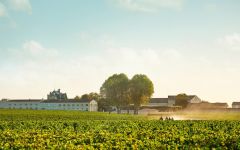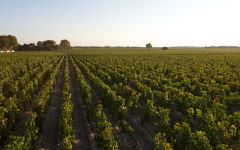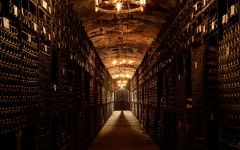Chateau Mouton Rothschild 1989
-
James
Suckling - Decanter
-
Wine
Spectator -
Robert
Parker



Product Details
Your Rating
Somm Note
Winemaker Notes
The wine has a deep color with an attractive ruby and garnet hue. The pleasantly smoky and toasty nose also reveals some notes of licorice, spice and cedarwood. The attack is round, with plenty of fruity freshness over sustained, silky tannins and subtle touches of caramel, wild berry fruit, vanilla, coffee and white pepper. The long finish is generous, harmonious and well-balanced. A very fine vintage indeed.
Blend: 78% Cabernet Sauvignon, 14% Cabernet Franc, 8% Merlot
About the Label Artwork
Born in 1938 as Hans Georg Kern, Baselist took his name from his native town of Deutschbaselitz in Saxony. He knew nothing about contemporary art until he left East Germany at the age of twenty. Initially his painting was marked by an iconoclastic license and a preoccupation with certain powerfully provocative images (mutilated feet, distorted penises, despairing masks), and by a subversive violence allied to a spiritual quest reminiscent of Antonin Artaud or Baudelaire.
In 1969 he created his first “upside down” painting. All his work since has employed this conceit, allowing the painter to find a “new distance” from the subject he is painting and to impose, without being any less figurative, a literal revolution on the way the public looks at the world.
His upside down rams for the Mouton Rothschild 1989 label bring together the traditional Mouton emblem with the great historical shock of that year: the demolition of Berlin Wall. He has added the words “Drüben sein jetzt hier” – “Over there is now over here”.
Professional Ratings
-
James Suckling
Freshly picked blackberries turn into minty dark chocolate and oozing caramel with domineering eucalyptus on the nose. It becomes yet more complex on the palate thanks to layers upon layers of spices and sage plus fat and rounded tannins. There's a long finish with a bitter aftertaste, suggesting this could do with another 10 years or more of bottle aging. This is a Mouton I found massive at the time, then elegant and slightly austere years later, but today true to its former glory. Like the amazing 1947, it should not be forgotten.
-
Decanter
An extremely early year for the property, with harvest from 6-25 September. One to savour, it has the signature smoked, toasted glamour of Mouton, with cappuccino, crushed bilberry and blackberries, pliable tannins, and a drawn-out finish that gets better and better in the glass. The label, by the way, featured Georg Baselitz, a German painter, to celebrate the fall of the Berlin Wall.
-
Wine Spectator
Shows so much ripe and decadent fruit on the nose, from dried berries and raisin to strawberry and sultana. There is a nutty, cedar undertone as well. Very complex and full-bodied, with lots of vanilla bean and ripe plum flavors. This is almost Burgundian in texture: so soft and so attractive, but then the Bordeaux tannins kick in at the end. What a wine. So much ahead in its life, but just coming around now.
-
Robert Parker's Wine Advocate
Tasted from magnum and presented by Baron Philippe Sereys de Rothschild, the 1989 Château Mouton-Rothschild might not reach the ethereal heights of the 1982 or 1986, but it is certainly a lovely Claret. It has an attractive, slightly leafy bouquet armed with cedar and pencil lead. There is less fruit concentration than I expected, resolutely classic, slightly austere Bordeaux. The palate follows suit. What it lacks in substance it compensates with in balance and personality. This is an understated Mouton-Rothschild that is probably at its peak, although I envisage this offering another two decades of pleasure. Whilst this showing did not replicate some glorious bottles in the past, it remains a very fine Claret that may not be inclined to improve any further. Tasted February 2016.
Other Vintages
2022-
Jeb
Dunnuck -
Robert
Parker -
James
Suckling - Decanter
-
Wine
Enthusiast -
James
Suckling - Decanter
-
Jeb
Dunnuck -
Robert
Parker
-
Robert
Parker -
James
Suckling - Decanter
-
Wine
Enthusiast -
Wine
Spectator -
Jeb
Dunnuck
-
Wine
Enthusiast -
James
Suckling -
Jeb
Dunnuck -
Wine
Spectator -
Robert
Parker - Decanter
-
James
Suckling - Decanter
-
Wine
Enthusiast -
Robert
Parker -
Wine
Spectator -
Jeb
Dunnuck
-
James
Suckling -
Wine
Spectator - Decanter
-
Jeb
Dunnuck -
Robert
Parker -
Wine
Enthusiast
-
James
Suckling -
Jeb
Dunnuck -
Robert
Parker - Decanter
-
Wine
Spectator -
Wine
Enthusiast
-
James
Suckling -
Jeb
Dunnuck -
Wine
Enthusiast - Decanter
-
Robert
Parker -
Wine
Spectator
-
James
Suckling -
Jeb
Dunnuck -
Wine
Spectator -
Wine
Enthusiast - Decanter
-
Robert
Parker
-
Wine
Enthusiast -
James
Suckling -
Wine
Spectator -
Robert
Parker
-
Wine
Enthusiast -
James
Suckling -
Robert
Parker -
Wilfred
Wong -
Wine
Spectator
-
James
Suckling -
Robert
Parker -
Wine
Spectator -
Wine
Enthusiast
- Decanter
-
Wilfred
Wong -
James
Suckling -
Wine
Spectator -
Wine
Enthusiast -
Robert
Parker
-
Robert
Parker - Decanter
-
Wine
Spectator -
James
Suckling -
Wine
Enthusiast
-
Jeb
Dunnuck - Decanter
-
Wine
Enthusiast -
Robert
Parker -
James
Suckling -
Wine
Spectator
-
Wine
Enthusiast - Decanter
-
Wine
Spectator -
Jeb
Dunnuck
-
Wine
Enthusiast -
Robert
Parker -
James
Suckling -
Wine
Spectator
-
Robert
Parker -
Wine
Spectator -
James
Suckling -
Wilfred
Wong -
Wine
Enthusiast
-
Wine
Spectator -
Wine &
Spirits -
Robert
Parker
-
Robert
Parker -
Wine
Spectator -
Wine
Enthusiast -
James
Suckling
-
Robert
Parker -
Wine
Spectator -
James
Suckling
-
Wine
Spectator
-
Wine
Enthusiast -
Robert
Parker -
Wine &
Spirits -
Wine
Spectator -
James
Suckling
-
Robert
Parker -
Wine
Spectator
-
Robert
Parker -
Wine &
Spirits -
Wine
Spectator -
James
Suckling
-
Wine &
Spirits -
Robert
Parker
- Decanter
-
Robert
Parker -
Wine
Spectator -
James
Suckling
-
Wine
Spectator -
Robert
Parker -
James
Suckling
-
Wine
Spectator -
Robert
Parker -
James
Suckling
-
James
Suckling -
Wine
Spectator -
Robert
Parker
-
James
Suckling -
Robert
Parker
-
James
Suckling -
Wine
Spectator
-
Robert
Parker - Decanter
-
Wine
Spectator
-
James
Suckling - Decanter
-
Robert
Parker
-
Wine
Spectator
-
Wine
Spectator -
James
Suckling -
Robert
Parker
-
Robert
Parker -
Jeb
Dunnuck -
James
Suckling -
Wine
Spectator - Decanter
-
Wine
Spectator
-
James
Suckling -
Robert
Parker
-
Wine
Spectator
-
Robert
Parker
-
James
Suckling -
Robert
Parker -
Wine
Spectator








A First Classified Growth, Château Mouton Rothschild spans 82 hectares (202 acres) of vines at Pauillac in the Médoc, planted with the classic varieties of the region: Cabernet Sauvignon (79%), Merlot (17%), Cabernet Franc (3 %), Petit Verdot (1 %). The average age of the vines is 50 years.
The estate benefits from exceptionally favourable natural conditions, in the quality of the soil, the position of its vines and their exposure to the sun. Combining respect for tradition with the latest technology, it receives meticulous attention from grape to bottle. The wine is matured in new French oak barrels.
Le Petit Mouton de Mouton Rothschild is the second wine of Château Mouton Rothschild.
The estate also comprises 6 hectares (15 acres) of sandy, gravelly soil planted with Sauvignon Blanc (51%), Semillon (40%) and Sauvignon Gris (9%), used to make its white wine, Aile d’Argent.
Brought to the pinnacle by two exceptional people, Baron Philippe de Rothschild (1902-1988) then his daughter Baroness Philippine (1933-2014), its destiny has now been taken in hand by her three children: Camille and Philippe Sereys de Rothschild, and Julien de Beaumarchais de Rothschild. True to their grandfather’s and mother’s work, all three are committed, with the same enthusiasm and determination, to perpetuating Baron Philippe’s dictum: “Live for the vine”. Almost a command, it means being there for the vineyard in good times and in hardship, serving it with skill and honouring it with art.
Château Mouton Rothschild is a place of art and beauty, famous for the spectacular vista of its great barrel hall, its remarkable vat room and its Museum of Wine in Art. Every year since 1945, the Château Mouton Rothschild label has been illustrated with an original artwork by a great contemporary artist. Dalí, César, Miró, Chagall, Warhol, Soulages, Bacon, Balthus, Tàpies, Koons and Doig are only some of the artists featured in a fascinating collection to which a new work is added each year and which makes up the Paintings for the Labels exhibition.

One of the world’s most classic and popular styles of red wine, Bordeaux-inspired blends have spread from their homeland in France to nearly every corner of the New World. Typically based on either Cabernet Sauvignon or Merlot and supported by Cabernet Franc, Malbec and Petit Verdot, the best of these are densely hued, fragrant, full of fruit and boast a structure that begs for cellar time. Somm Secret—Blends from Bordeaux are generally earthier compared to those from the New World, which tend to be fruit-dominant.

The leader on the Left Bank in number of first growth classified producers within its boundaries, Pauillac has more than any of the other appellations, at three of the five. Chateau Lafite Rothschild and Mouton Rothschild border St. Estephe on its northern end and Chateau Latour is at Pauillac’s southern end, bordering St. Julien.
While the first growths are certainly some of the better producers of the Left Bank, today they often compete with some of the “lower ranked” producers (second, third, fourth, fifth growth) in quality and value. The Left Bank of Bordeaux subscribes to an arguably outdated method of classification that goes back to 1855. The finest chateaux in that year were judged on the basis of reputation and trading price; changes in rank since then have been miniscule at best. Today producers such as Chateau Pontet-Canet, Chateau Grand Puy-Lacoste, Chateau Lynch-Bages, among others (all fifth growth) offer some of the most outstanding wines in all of Bordeaux.
Defining characteristics of fine wines from Pauillac (i.e. Cabernet-based Bordeaux Blends) include inky and juicy blackcurrant, cedar or cigar box and plush or chalky tannins.
Layers of gravel in the Pauillac region are key to its wines’ character and quality. The layers offer excellent drainage in the relatively flat topography of the region allowing water to run off into “jalles” or streams, which subsequently flow off into the Gironde.
